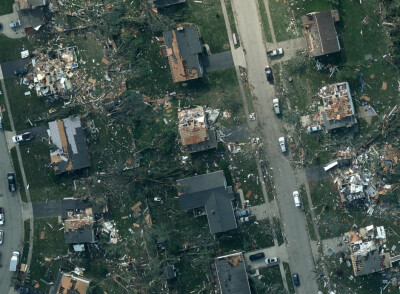Vexcel Imaging announced their latest camera release based on Vexcel Imaging’s 4th generation camera architecture, the UltraCam Condor 4.1. The aerial camera addresses a very specific application: high-altitude ortho image generation with superior image quality and flying efficiency. This is a result of data requirements from organizations such as governmental and scientific agencies. To them, data is more meaningful in a broader context and over a larger geography. As airborne sensors have continued to evolve and allow for the collection of larger areas of interest, wide-area mapping has become more economical, therefore more feasible, and provides more information more quickly, making information derived from the data more rapidly actionable.
Different lens systems
The UltraCam Condor 4.1 aerial camera design consists of a very wide, high-resolution RGB array that delivers the utmost resolution and flying efficiency due to its across track footprint of 48,462 pixels. The system also features a lower resolution rectangular NIR for classification projects and a lower resolution rectangular PAN for producing highly accurate DSMs and DTMs through dense matching. Due to the rectangular image footprint, frontlap of 85% is obtained for maximum dense matching quality.
The UltraCam Condor 4.1 features different lens systems to collect RGB, PAN and NIR all simultaneously. The full 48,462 pixel resolution is provided through the RGB channel and corresponding lens. Meanwhile, the PAN and NIR capabilities are provided through independent channels, each with its own lens in the same camera. The PAN channel is the photogrammetric backbone of the UltraCam Condor and enables generation of point cloud, DSM and DTM from the PAN imagery which are then being used to generate the DSMortho images and DTMortho images. So, there is no additional data required such as lidar point clouds to generate the final image products. The NIR channel of the UltraCam Condor supports classification such as land use for example.
Operating at rapid speeds
Benefitting from UltraCam 4th generation technology, the UltraCam Condor 4.1 features numerous enhancements that begin with a fully CMOS-based architecture that enables a fast frame rate of 1 frame per 0.7 seconds, allowing customers to operate the system reliably even with jets and turboprobs at rapid speeds.
Utmost aerial data collection efficiency is achieved when aircraft are able to fly at faster speeds. This requires a fast cycle rate by the sensor and the ability to handle motion blur. 170 knots would be considered “rapid” and can be accomplished with the UltraCam Condor, given its 0.7 second frame rate and Adaptive Motion Compensation technology. If operated in Jets, the Condor could even be operated beyond 200 knots and on flight lines of 150 km or longer which boosts nationwide mapping to another efficiency level.
New temperature-controlled lenses
To manage the vast amount of data collected by the CMOS sensors and still maintain the impressive image dynamic enabled by the latest CMOS technology, completely new electronics were implemented for UltraCam 4th generation systems, such as new temperature-controlled lenses, designed solely for Vexcel Imaging, which ensure imagery of exceptional sharpness, resolution, and contrast.
The 4th generation UltraCam is based on the latest CMOS technology. Due to the smaller pixel size on the current CMOS sensors compared to previous CCD generations, Vexcel has decided to develop a new series of lenses for the 4th camera generation. The new lenses address the smaller pixel size and are capable of resolving the higher resolution of the current and also next series of CMOS sensors. That ensures that the lenses are capable to resolve the full range of resolution and image dynamic of the CMOS sensors. All lenses are equipped with a temperature sensor and the lens temperature is recorded for each exposure. This allows Vexcel to compute temperature differences recorded during calibration and when taking a production image. The lens design is specifically tuned to keep the image quality at an optimal level for the required temperature range.
Adaptive Motion Compensation
A new, innovative feature, exclusive to all UltraCam 4th camera generations, is the Adaptive Motion Compensation (AMC). AMC is an innovative motion compensation approach that, in addition to correcting image blur in the direction of flight as provided by traditional Forward Motion Compensation (FMC) technology, also addresses blur caused by multi-directional camera movements during flight.
One of the main benefits of AMC is its software-based solution. There are no additional mechanical parts in the camera body which may degrade or cause malfunctions. The AMC technology was developed by Vexcel Imaging in 2020 for the UltraCam sensors of the 4th generation. AMC is available through the latest UltraMap Software.
AMC is implemented in the post-processing software UltraMap and corrects multi-directional and multi-scale blur during post-processing. That is available for all 4th generation UltraCam cameras such as Osprey 4.1 and Condor 4.1. Like for the Osprey 4.1, each image of the Condor 4.1 taken by a camera cone is corrected based on parameters from the GPS/INS system such as speed and angular velocity and also camera design parameters.
UltraCam Condor 4.1 and Condor M1 Differences
The Condor M1 was based on UltraCam third generation technology that, first and foremost, was based on CCD technology with a corresponding pixel pitch of 4.6um, frame rate of 1.75 seconds, and an image footprint of 38,000 pixels across the flight path. The system featured Forward Motion Compensation (FMS) through Time Delayed Integration (TDI). In contrast, the Condor 4.1 is CMOS-based with a corresponding pixel pitch of 3.2um, frame rate of 0.7 seconds, and an image footprint of 48,462 pixels across the flight path. It houses all new electronics, lens that were custom developed for Vexcel and Adaptive Motion Compensation which addresses motion blur in all directions (as opposed to just forward direction), which collectively significantly improves image quality beyond the already impressive imagery generated by the Condor M1.








